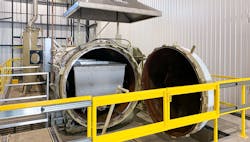Daniels Health has set a worldwide standard for safe sharps collection within the medical waste industry. Daniels Health, based in Australia, was started in 1986, and now operates medical waste processing facilities in Australia, New Zealand, South Africa, Canada, the U.S., and the U.K.
This article is part of our monthly What Works column. Read more from our monthly What Works series.
The management of medical waste is highly regulated. In Canada, medical waste is referred to as “biomedical waste,” and in the U.S., it is referred to as “regulated medical waste,” says Daniel Kennedy, CEO for Daniels Sharpsmart Canada, Ltd.
Of the four categories of medical waste, the majority, between 80 to 85 percent of the total medical waste volume, Kennedy says, is considered regular biomedical waste, such as bloody bandages, gauze, contaminated IV tubing, petri dishes, or biological specimens. The remaining 15 to 20 percent is categorized as: 1) anatomical or pathological waste, which would be human tissue, or animal tissue generated through research; 2) chemotherapy or cytotoxic waste, which is generated through the treatment of a cancer patient; 3) pharmaceutical waste, such as a syringe containing the pharmaceutical, empty pharmaceutical vials, empty I.V. bags and tubing.
“A sharp containing a residual pharmaceutical that has been injected into a patient is considered a regular biomedical sharp, whereas a sharp containing a residual pharmaceutical that has not been injected into a patient, but rather injected into an I.V. bag or used in a laboratory environment, would be considered a pharmaceutical waste sharp,” Kennedy says.
The latter three categories must be incinerated. The remaining regular biomedical waste may be incinerated or processed through other approved alternate treatment technologies.
To process its non-incineration medical waste at its facility in Abbotsford, BC, Daniels Health uses autoclave high-pressure, high-temperature steam sterilization technology. The steam needed to fill the 6- by 35-foot pressure vessel puts incredible demand on a boiler, and at Daniels Health’s Brampton, ON, processing facility, it was time for an upgrade to a new Clayton Industries SigmaFire SF200 boiler with 200 hp and 300 psig.
Medical waste processing: from patients to landfill
Daniels Health network of transport vehicles picks up medical waste at hospitals and other healthcare facilities throughout British Columbia, and transports it to the Abbotsford processing facility. Containers of medical waste, identified by generator and waste specific bar-code labels, are offloaded from the vehicles and are staged for processing. Then, the waste containers are fed through a computerized waste scale station, where each unit is measured for radiation, database scanned and weighed, automatically deducting the tare weight of any reusable containers.
“Processed waste containers are then segregated by waste type. Processible waste is staged for autoclave treatment and incineration waste is palletized, shrink-wrapped, and consolidated for transport off-site for third party incineration,” Kennedy says.
Containers of processable waste that can be autoclave treated are then decanted from the packaging into large stainless steel autoclave bins. A full autoclave cycle averages about 1.8 metric tonnes of waste. The bins are rolled into the autoclave for the one-hour sterilization process cycle. The high-pressure heat reduces the volume of the waste by about 50 percent. From there, the contents are decanted into a 40-cubic-yard self-contained waste container, and once filled, that compactor gets hauled away and emptied at an approved local landfill. “The contents are 100 percent sterile,” Kennedy says.
Daniels Health relies on boilers to produce the steam required to fill and pressurize its autoclave processing units. The company has used coiled tube boilers previously, but in the beginning, it purchased reconditioned units. They worked fine but consumed a lot of gas and required constant maintenance. Daniels Health did eventually invest in new boiler technology, but those were still not very fuel efficient, and the cycle time, which is dictated mostly by how fast the boiler can produce steam, was still not fast enough. Once Daniels Health was introduced to Clayton boilers, it realized a shorter cycle time, better fuel efficiency, and a smaller footprint on the plant floor. This is the third Clayton boiler installed at Daniels’ Canadian facilities.
To reduce the autoclave cycle time to under one hour, Clayton designed a 360-gallon steam accumulator to accompany the vertical coiled tube boiler.
“The accumulator stores a reserve amount of high temperature steam that is generated by the boiler,” Kennedy says, “So when the autoclave calls for steam, it doesn’t rely 100 percent on just the boiler. It pulls reserve steam from the accumulator, so the boiler and accumulator can fill the autoclave with that pressurized steam much more quickly.” The Clayton boiler reduced each autoclave cycle by approximately 20 minutes.
Steam generator and counter flow
This year, Clayton Industries celebrated its 90th anniversary selling industrial steam boilers. “We build industrial steam boilers in a manner that’s a little different. That’s why we call them steam generators,” says John Clayton, president and third-generation owner of Clayton Industries.
The company was founded in 1930 in Los Angeles, making small boilers for the U.S. market. As the product line expanded, Clayton made larger and larger capacity boilers. After the second world war the business expanded globally. “We’ve excelled in low pollution, low emission burner systems,” Clayton says.
The boilers use a counter flow heat exchanger to produce steam. “Heat travels through the heat exchanger in one direction, while the water flows in the opposite direction,” Clayton says. Through the laws of physics, this leads to better heat transfer. More of the heat from the fuel goes into the water and less waste goes out the stack.
In sizing the right boiler, Ron Polidori, Canadian sales manager at Clayton Sales & Service, Ltd., says it’s important to make sure the capacity needed in the system is within the capability and capacity of the boiler. The challenge for Daniels Health boilers was the huge demand for steam at the start of the processing cycle. “That’s when we started looking at the accumulator option,” Polidori says. “It’s a pressurized vessel with water and steam. It’s charged and ready to provide steam instantly.” At the onset of the process cycle, the autoclave has an immediate demand for steam. The accumulator starts adding steam to the autoclave instantly, while the boiler is brought up to the required pressures and temperatures. When the processing equipment no longer needs added steam, the boiler can recharge the steam to the accumulator.
The counter flow design, which brings water in from the top and flows it down to the heat source, maximizes the heat transfer, compared to horizontal boilers, which run a parallel flow, where the water and burner are flowing in the same direction. The vertical coiled tube boiler also provides significant space savings over horizontal boilers.
Steam quality and maintenance
Many factors can affect steam quality, says Polidori, including the design of the boiler or the water level in the boiler. Clayton steam generators use a dedicated steam separator, which separates out the water and delivers 99.9% dry saturated steam. “If you don’t have a dedicated steam separator, your steam quality will be lower and very inconsistent, and you can get fluctuations in quality,” Polidori says.
The boilers do need regular maintenance, and Clayton boilers come with commissioning and training included in the price of the boiler. “We teach people how to care for it, how to run it and how to troubleshoot,” Clayton says. The company also provides customized or standard customer maintenance service packages.
Every customer is a little different, but Polidori says Clayton establishes clients’ preventative maintenance schedules on average for every three to four months. Glenn Adgey, vice president of North America sales for Clayton, says the first level of maintenance is daily checks by on-site workers, who visually inspect the equipment. Next, chemical testing is important. Water tests are done “to make sure the water you’re putting in won’t damage the boiler,” Adgey says. Clayton asks clients to test every day, and it backs up those tests on service appointments. “If you use acidic water, it can damage tubing in the boiler,” Adgey says. Lime scale can also build up, he says, which acts as an insulator, causing the equipment to overheat and possibly crack because it can’t cool down. “We check for soft water too,” Adgey says.
One of the biggest maintenance and long-term safety features of the Clayton boiler is its inability to explode. “We are a coiled tube design, so the water is inside the water tubes,” Adgey says. “As an analogy, you run over a garden hose and you cut it. You can only release the amount of water in the diameter of the hose. It’s the same thing with the boiler. We can’t release all the energy at once with the tube design. We can only release a cross-sectional value, controlled release vs. explosion potential.”
The Clayton Industries boiler provided Daniels Health with a more efficient cycle, significant cost savings, and a smaller footprint. “Clayton doesn’t claim to be the least expensive, but we provide the best value and best long-term affordability,” Polidori says. It’s also important, he says, to consider the total cost of ownership vs. the capital costs. The capital cost can be a small portion of the customer’s total investment in the boiler over its lifetime, considering fuel and maintenance costs.
In June, Daniels Health secured a new contract with the national buying group HealthPro. All health authorities within the province of British Columbia manage their medical waste through an organization called PHSA, which is a HealthPro member. “That contract is one of the most encompassing single contract opportunities within that national buying group because it represented all of the hospitals within B.C. as well as all the off-site facilities,” says Kennedy. The contracts included approximately 600 locations, which in total will generate approximately 3.5 million kilos of medical waste annually.
The volume of waste would have challenged the original reconditioned boiler design at the new B.C. facility, running 20 cycles per day. Now, Daniels Health can meet those needs and continue to grow, with high quality steam at a shortened cycle.
Daniels Health has maintained and continued to expand its operations as an essential business during the pandemic, though it has not necessarily seen significantly increased waste volumes due to COVID-19. “Health care volumes were impacted by COVID. Healthcare generates a significant amount of COVID waste within an institution; however, legislators have deemed any of the PPE that is associated with COVID isn’t medical waste, so it can be deposited to the regular waste stream,” Kennedy says. With hospital focus on COVID-related patients, many elective surgeries are suspended, so facilities aren’t necessarily generating additional waste because of COVID.
Medical waste volumes overall continue to grow, Kennedy says, as the population ages. “We’re experiencing a lot more growth within the off-site patient care sector, especially within long-term care homes, and home health care,” Kennedy says.
About the Author

Anna Townshend
managing editor
Anna Townshend has been a journalist and editor for almost 20 years. She joined Control Design and Plant Services as managing editor in June 2020. Previously, for more than 10 years, she was the editor of Marina Dock Age and International Dredging Review. In addition to writing and editing thousands of articles in her career, she has been an active speaker on industry panels and presentations, as well as host for the Tool Belt and Control Intelligence podcasts. Email her at [email protected].
